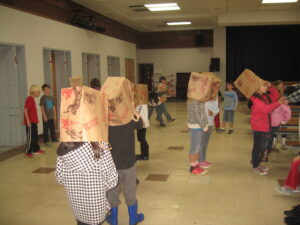Can You Hear Me Now?

Author(s): Dennis Eaton
Subject: Life Science
Grade Level(s): Grade 3, Grade 4, Grade 5
Big Idea(s): Many animals depend on their senses to protect themselves. Some animals improve their chances for survival by staying in groups of their own kind.
What you need: 11 brown paper shopping bags or blindfolds
5 different identical pairs of noisemakers
1 noisemaker unlike any other
“Adaptations Journal Form” (attached)
Setting: The lesson needs to take place in a large area, preferably on the playground or in a multi-use room.
Time Needed: This lesson takes about 30-45 minutes.
Summary:
Students will take the role of an animal with poor or limited vision, and must rely on their hearing for “survival”. They will attempt to locate another animal of their species, based on sound. One student will be the predator, with his/her own unique sound.
Learning Goals / Objectives:
Students will learn that adaptations in physical structure or behavior may improve an organism’s chance for survival.
Standards:
3.a. Students know plants and animals have structures that serve different functions in growth, survival, and reproduction.
4.d. Students will predict the outcome of a simple investigation and compare the result with the prediction.
4.e. Students will collect data in an investigation and analyze those data to develop a logical conclusion.
Background
Animals rely on their senses to protect them from danger, as well as to find food. While vision is of paramount importance for many, hearing is just as important, or more so, for some animals. These may be animals with poor eyesight, or ones that are nocturnal and therefore limited in their ability to see danger due to the darkness.
Setup:
You will need 5 pairs of matching sound makers (i.e. — 2 rattles, 2 tambourines, etc.) You will also need one sound maker that is unique from all the others. I borrowed small hand-held instruments from our music teacher (highly recommended), but if you don’t have that resource available to you, you can make your own sound devices. Fill small containers with different objects (beads, paper clips, sand). You could also use two small blocks of wood, two spoons, two pan lids to use as cymbals, etc.
Cut out and glue the “Adaptations Journal Form” (attached) into the students’ Science Journals.
Anticipatory Set:
Ask students to imagine that they are an animal with poor vision or are active only at night when vision is restricted. What other senses might they rely on to survive? What animals do you need to stay away from? What animals may help you to survive? In this activity you will use your hearing to find your partners and avoid being eaten by the predator.
Instructions / Activities:
1. Choose 11 students to participate. Have the rest of the class from a large circle around them.
2. Have all the participants put on a paper bag/blindfold.
3. Hand out the paired noisemakers. No one is to know what noisemaker anyone else has.
4. Give one student the unique noisemaker and let this student know that he or she is the predator with a tap on the shoulder.
5. Spread the participants over the designated area.
6. Give the signal to sound off. The object of the game is for each student to find the animal that makes the same noise as he or she does (the secret partner) and then to stay together and avoid being tagged by the predator (eaten) until the game is over.
7. Important: Students can sound off only when standing still, not while moving.
8. If tagged by the predator, students take off their masks and move to the edge of the circle. Predators must be sure the prey know they have been tagged. If partners find each other before the predator does, they must stay together and continue to avoid the predator until the game is over. At this point, they are no longer required to make a noise. (Optionally, you may declare a pair that finds one another “safe” and remove them from the designated area, rather than have them try to elude the predator as a pair).
9. The game is over when the leader calls time.
10. Allow about five minutes for the game and then choose new participants.
Assessment:
Formative assessments:
Upon returning to the classroom, lead the students in a discussion within their table groups about what they observed/learned during the activity, using the questions in the “Wrap-up/Closure” section below.
State a vocabulary word aloud and have students share its meaning with their think/pair/share partner. Call on volunteers to share with the class.
Summative assessments:
Students will complete the “Adaptations Journal Form” (attached) in their Science Journals.
End of unit test on Life Science.
Wrap-up / Closure:
Class discussion of the following questions…
What helped you to identify your partner?
What helped you to identify your predator?
How can hearing be important to animals?
Are there any animals you can identify by hearing?
What animals can you name that depend on their hearing for survival?
Also…
You can Google “animal sounds” and play them for your class. Have them try to guess the animal. This can also be a fun activity for the Anticipatory Set.
Tags: Grade 3, Grade 4, Grade 5
Categories: Life Science

